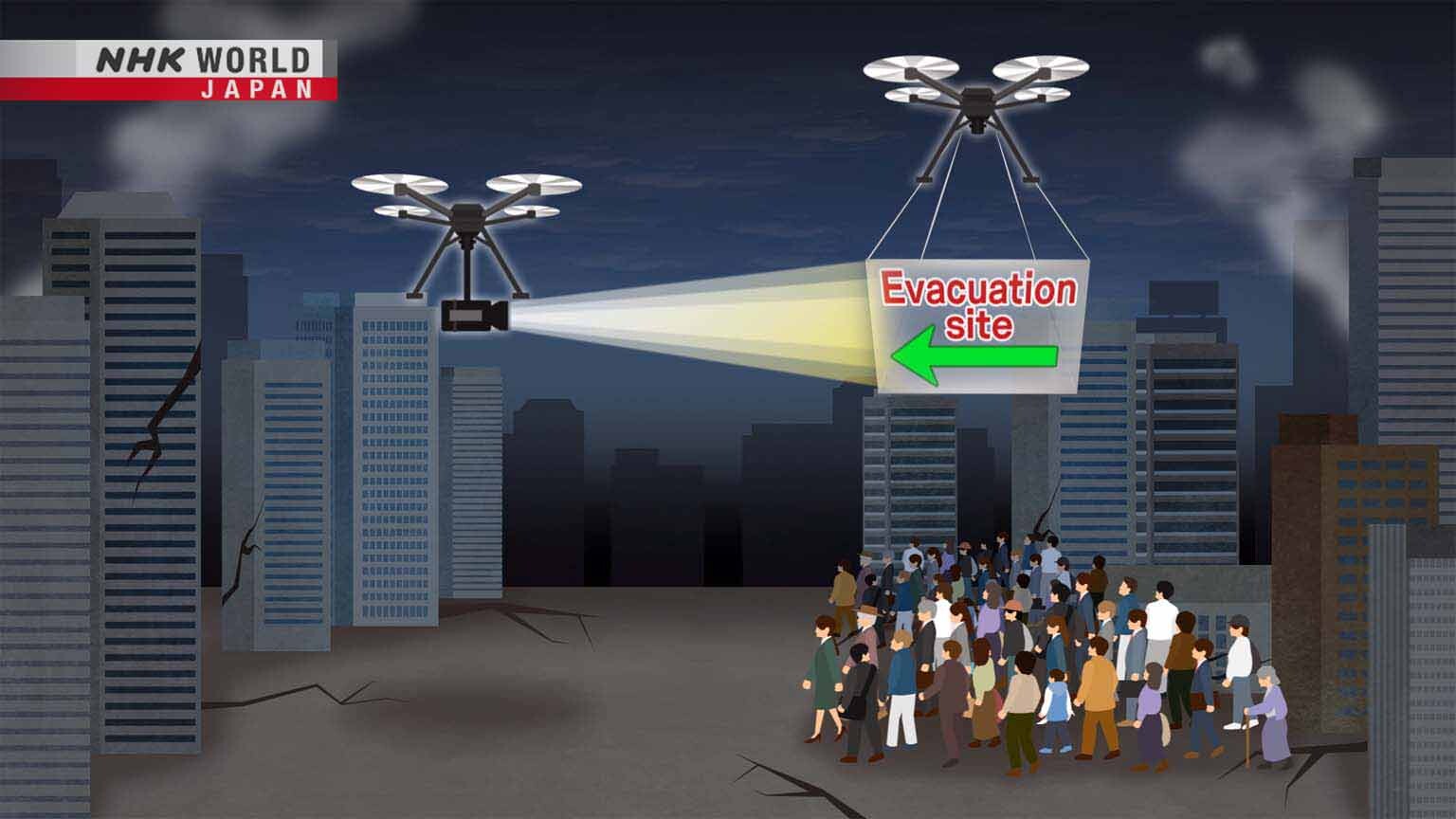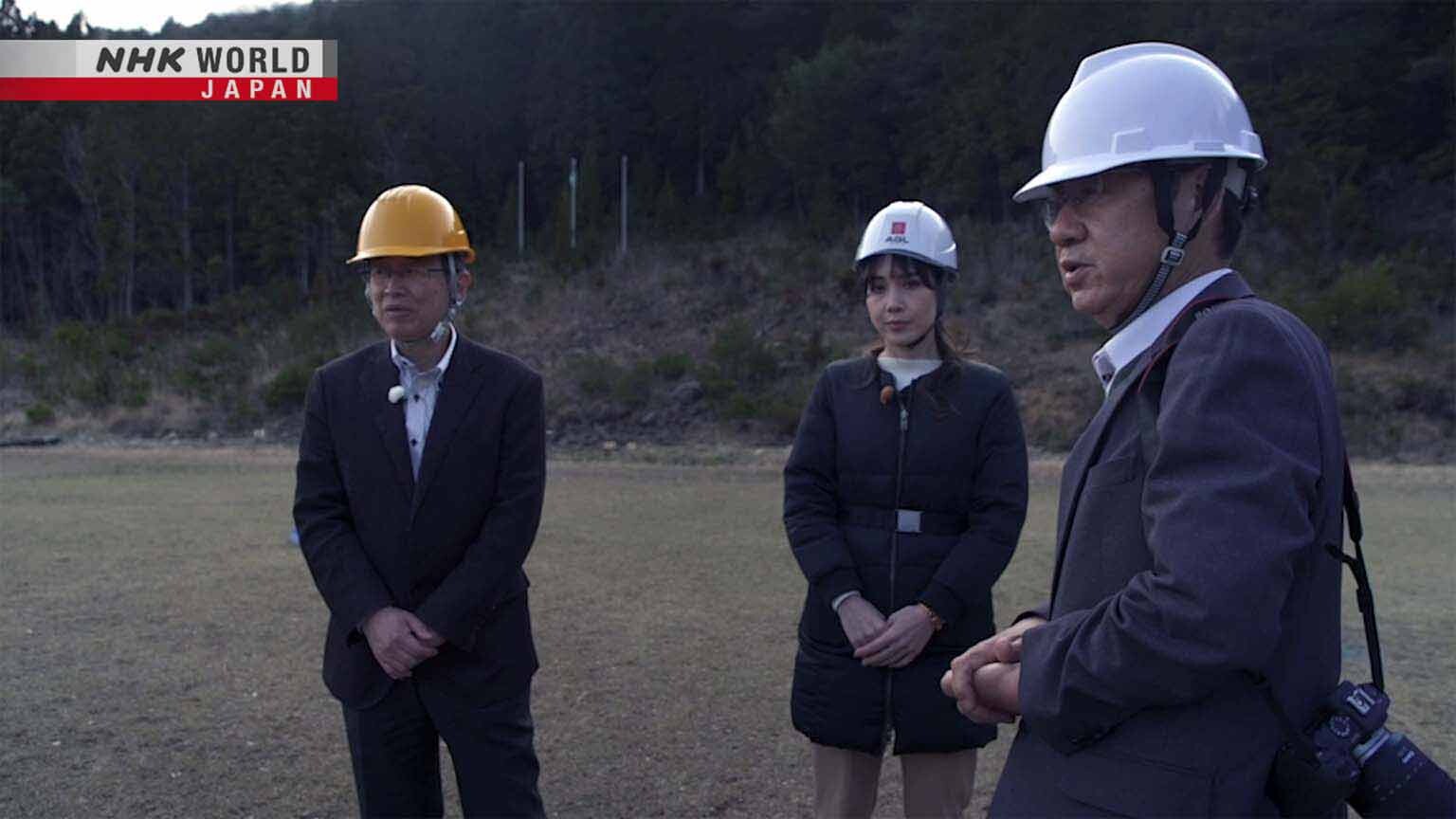#43 Drone Disaster Management
Drones are proving particularly useful in the area of disaster response. Now, Osaka University is developing the world's first system to project evacuation information in the air.



Transcript
In recent years, drones have become a familiar presence.
From agricultural work...
to building inspections...
and delivery, they are now used in a variety of situations.
And drones are proving particularly useful in the area of disaster response.
Drones can be used to quickly assess the situation in disaster areas and deliver supplies to isolated places.
This was delivered by drone.
It was really helpful.
In today's program, we'll learn about a world-first attempt to use drones to project evacuation instructions in the air.
We can see it quite clearly.
Let's take a closer look at the researchers developing drones to save lives in disasters.
This is the Institute of Laser Engineering at Osaka University,
where research is being conducted to combine lasers and drones in the area of disaster response.
Dr. Kazuhisa YAMAMOTO is the project leader.
In the event of a major disaster, evacuating people safely is vital.
We've developed an aerial sign system
which projects images in the air to help people evacuate.
When earthquakes and other disasters strike, evacuation is critical.
After a large earthquake, a tsunami may occur.
In the Great East Japan Earthquake of 2011,
it's estimated that 90% of the approximately 18,000 people who died were swept away in the ensuing tsunami.
Fires may also occur.
In the Great Kanto Earthquake of 1923, approximately 92,000 people died in the fires that broke out.
Confusion during evacuation is also a risk.
It can lead to panic, and people may die from being crushed in a crowd.
To project text or images in the air, they use one drone equipped with a laser projector,
and another drone equipped with an aerial screen.
These signs are used to guide people to a safe place.
The research team is the first in the world to attempt this.
The first test was conducted in 2022, three years after the project started.
Here is how it works.
Two drones rise to a height of 20 meters.
Then a laser is beamed from the projector to the screen.
The characters for "earthquake" and evacuation images were clearly projected on a huge 6x6-meter screen.
It's clearly visible from a distance of about 500 m.
That's quite a long way.
By using this system, it will be possible to communicate evacuation information to people within a radius of one kilometer.
The system works by using a laser beam instead of a lamp as the light source.
You can see it clearly.
The advantage of laser projectors is that they remain in focus regardless of the distance.
To mount the laser projector on the drone, they had to reduce its weight.
The projector is very small, about the size of a cell phone power bank.
It weighs about 100 g.
It's really light.
It's only about the size of a small Chihuahua.
We reduced weight by removing the camera and unnecessary parts on the projector.
The projection screen must also be lightweight.
They came up with this idea.
You can see through a fine mesh like this.
It looks like a bit like a window screen.
It's sometimes called an "amido" screen.
By using a mesh, the weight is reduced to 135 grams per square meter.
A mesh is also less affected by wind.
It's been able to withstand winds of around 7 to 8 m/s.
The research team is currently working on a new idea.
We are developing a drone that combines a screen and projector.
This system works by mounting a projector and a screen on one drone.
The text or image displayed will be smaller,
but since only one drone is needed, evacuation instructions can be issued more quickly.
I'm a little concerned about it hovering in a stable position,
and displaying the text or image clearly.
We're working hard to make it a success.
They are preparing for a test flight in a month's time.
There are some other disaster response initiatives that use drones.
This image was created by stitching together multiple photos taken by drones, with correction for distortion.
It's called an orthoimage.
It's a composite of over 100 photos.
Not only can you see the damage over a wide area,
but if you zoom in, you can also see details such as roads covered in dirt, as well as people.
This system, developed last year, has a special feature.
The drones all move together.
The five drones are linked and move in unison.
This enables the team to take photos of a large area quickly and efficiently.
Here is the resulting image.
With its high resolution, the team thinks it will be useful for quickly locating missing persons.
A month later, I returned to the Osaka University test site.
The team is conducting a test on the new aerial sign system.
Hi.
Hello.
Thanks for inviting me.
Are you nervous today?
This is our first attempt to fly a drone with both a projector and a screen.
The screen hangs below the drone,
so it's important to keep it steady in the face of wind and propeller airflow.
They are also testing a special drone that displays evacuation instructions over a long period of time.
A normal drone only has a battery, but this one also has a generator.
A normal drone can only fly for about 20 minutes, but this one can fly for over an hour.
They are preparing to operate the projector in the air.
We have to be careful about instability.
If the drone is unstable when flying, we have to bring it down right away.
Much of the equipment is handmade, adjusted through trial and error.
It's OK for now.
After three hours of work, it's ready to go.
They are testing two screens: one for daytime use and one for nighttime use.
First, they test the daytime screen.
Its material does not allow much sunlight to pass through, so that the sign can be seen even on sunny days.
Will it work?
The laser experts and drone staff look on nervously.
It's projected onto the ground.
It's being pushed around by the wind.
The screen is being blown around by the drone's airflow.
Is it difficult to control?
I sort of expected this, but it's being pulled down by its own airflow.
The downward airflow from the drone's propellers is hitting the screen, making it unstable.
It's moving about.
If the screen doesn't have holes, the air cannot pass through.
It won't pass through at all.
We need to use a mesh rather than a sheet.
It's getting dark, so that's enough for now.
Unfortunately, the daytime screen test was not a success.
Hopefully they will have more success with the nighttime screen.
Is it ok for me to do this?
Is this correct?
That's ok.
If we succeed, it will be thanks to you.
Thanks.
That'd be great.
The nighttime screen test begins.
The drone is slowly rising.
It's a bit windy.
But it's starting to be visible.
I can see S and O.
They adjust the angle of the projector to center the text on the screen.
We can see it quite clearly.
It's still 10 minutes before sunset.
The letters "SOS" were clearly displayed on the 1.5-meter square screen.
The team plans to further develop this aerial sign system,
with the aim of putting it into practical use within three years.
We can project images onto liquids and gases such as mist and smoke.
We haven't been able to install this system on a drone yet,
but we will try to do so.
Drones that can save your life.
I was surprised by how advanced the use of drones has become for disaster preparedness.
I am convinced that drones will play a very important role in saving lives during disasters in the future.